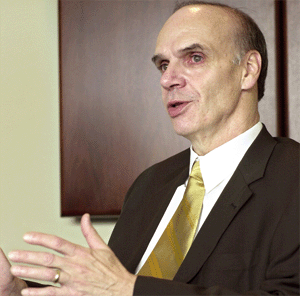2007 forecast: modest growth

Despite a proposed fiscal 2007 presidential IT budget that remains relatively flat ? the overall increase is only 2.8 percent over last year's enacted levels ? IT contractors likely will continue to see plenty of business opportunities.
Despite a proposed fiscal 2007 presidential IT budget that remains relatively flat ? the overall increase is only 2.8 percent over last year's enacted levels ? IT contractors likely will continue to see plenty of business opportunities."Anybody that gets an uptick in their budget should be thanking the budget gods," said John Palafoutas, senior vice president and chief lobbyist at the American Electronics Association, a trade group that lobbies state, federal and international governments.The hot areas for spending and contracting opportunities are homeland security, health care IT and information and IT security."As contractors, we'd like to see the budget increase be larger, but we are at least seeing increases, and in certain areas we're seeing more significant increases," said Ellen Glover, chairwoman of the Industry Advisory Council and executive vice president of ICF Consulting Group Inc. of Fairfax, Va. "All of us will have to look at what the priority areas are and the opportunities focused on those priority areas."The proposed 2007 IT budget is pegged at $64.3 billion. Of this amount, the Defense Department IT portion inched up by 0.3 percent over the enacted 2006 budget amount to $30.5 billion, while civilian agency IT spending jumped by 5.1 percent to $33.7 billion.The Homeland Security Department is one of the biggest gainers in the president's proposed 2007 IT budget; it would get a 21.2 percent increase to $4.4 billion, $772 million more than the $3.6 billion enacted for 2006.The department will be picking up speed on technology projects like the U.S. Visitor and Immigrant Status Indicator Technology program, known as U.S. Visit, which screens visitors entering the United States against criminal and terrorist data bases, and the Secure Border Initiative, a plan to secure America's borders and reduce illegal immigration. The initiative in part will upgrade technologies that control borders and expand the use of unmanned aerial vehicles and next-generation detection technology.Because U.S. Visit will require first-time enrollees to submit 10 digital fingerprints to improve the system's accuracy, the 2007 proposed budget includes a $60 million increase to deploy the 10-print equipment and for interoperability with the FBI's fingerprint identification system. It also includes a $71 million increase for the FBI to upgrade its Integrated Automated Fingerprint Identification System, and a $10 million increase for the State Department to put the new security measures in place.The 2007 budget also allocates more than $3 billion dollars for border patrol ? a 29 percent increase over 2006 ? that includes funding for 1,500 new agents and $100 million for new technology such as portable imaging machines, cameras, sensors and automated targeting systems that focus on high-risk travelers and goods.The administration's desire to improve the structure of DHS' Federal Emergency Management Agency and its ability to respond to disasters will present further opportunities for IT-related consulting services, said Renato DiPentima, president and CEO of SRA International Inc., Fairfax, Va.The 2007 proposed budget includes $3.1 billion for Federal Emergency Management Agency activities, an increase of $363 million over the 2006 level. The administration has requested about $1.9 billion for the agency's Disaster Relief Fund for disaster response and recovery costs costs, an increase of $189 million over last year's level.The budget also asks for about $70 million in additional funding for FEMA's primary operational accounts to improve operational and oversight capacities and to enhance alert-issuing capabilities and early warning systems.Another hot area will be health care IT. In the proposed 2007 budget, for example, the Health and Human Services Department has a 4.8 percent increase: $249 million over the $5.2 billion enacted budget for 2006.To meet the administration's goal of creating electronic health records and making them available to doctors for access to patients' medical histories, the proposed budget would fund health IT initiatives, including $169 million to accelerate e-record efforts. Of this amount, $116 million is designated for the Office of the National Coordinator for Health IT, which advises the Secretary of HHS on the development and nationwide implementation of an interoperable health IT infrastructure and technology programs.Some of the other health care IT efforts include promoting nationwide interoperability of health IT systems, defining the main elements of basic electronic health records for use in clinics, tracking new developments in health systems architecture and encouraging patients to keep their medical histories on their own computers.As contractors wait for opportunities related to the nationwide health care IT system, they will continue to find business in providing other systems to the health care industry."Most health care expenditures [by the government] go out to the providers, to the doctors in the hospitals and the nursing homes, but that portion that does go to IT is related to payment processing systems and systems like data mining that help more efficiently run the programs," DiPentima said.Information and IT security also will present some opportunities for contractors. In 2007, the Office of Management and Budget will require departments and agencies to address gaps in information security before adding new IT functions in other areas, according to the Information Technology Association of America. The trade association for IT professionals said the 2007 budget was the first to address information security spending on a per agency basis with a spending increase of 2.2 percent to $5.2 billion."We're pleased to see an increase in funding for information security, but the enhanced discipline of OMB's new policy could make the real difference," said ITAA president Robert Laurence. "Some vulnerabilities in federal systems and networks have been left to fester for far too long."Staff Writer Roseanne Gerin can be reached at .

Funding fingerprints
Secure the data
rgerin@postnewsweektech.com

"I don't think people from the Pentagon and other agencies will be coming in to click and download individual files. They'll want entire databases." ? Kenneth Thibodeau, electronic archives project director, NARA
Funding fingerprints
Secure the data
rgerin@postnewsweektech.com
NEXT STORY: Find the right box for your data

